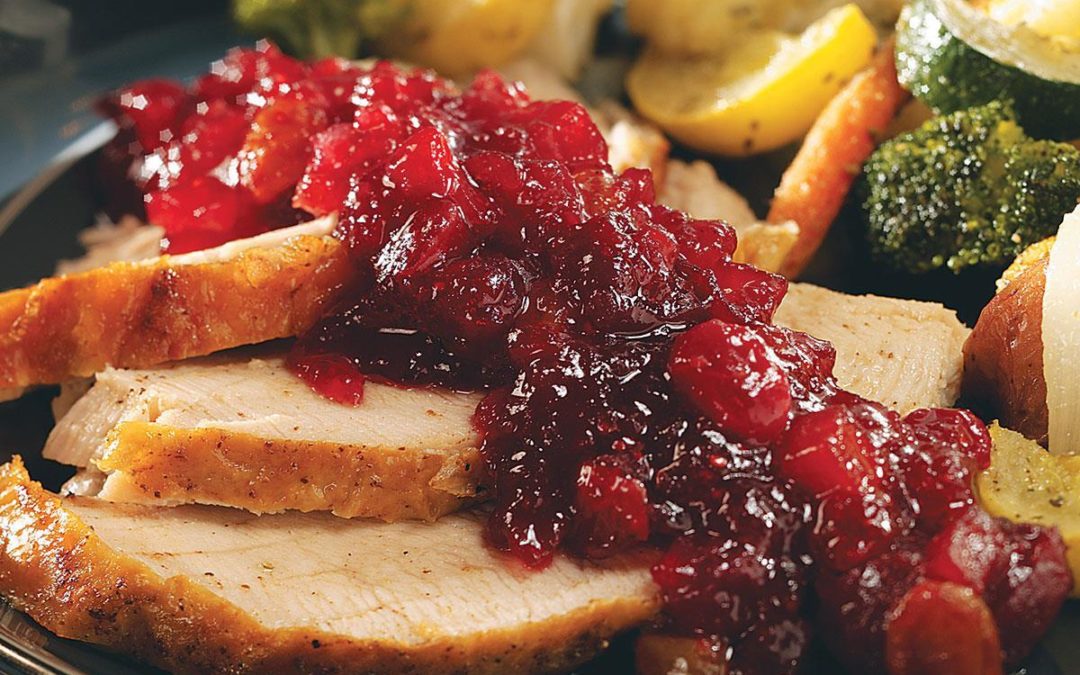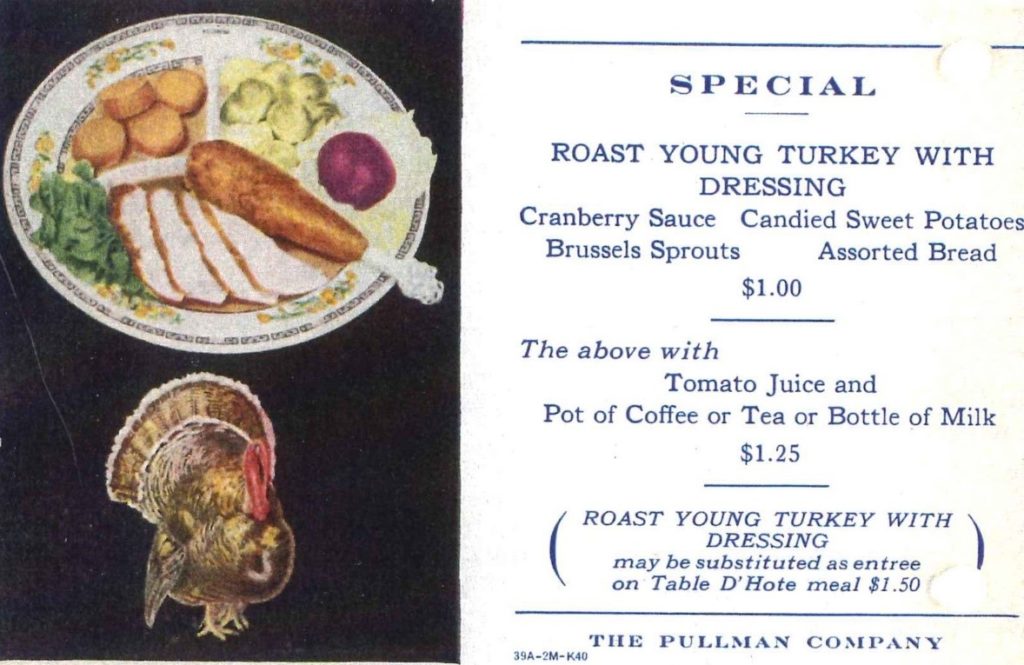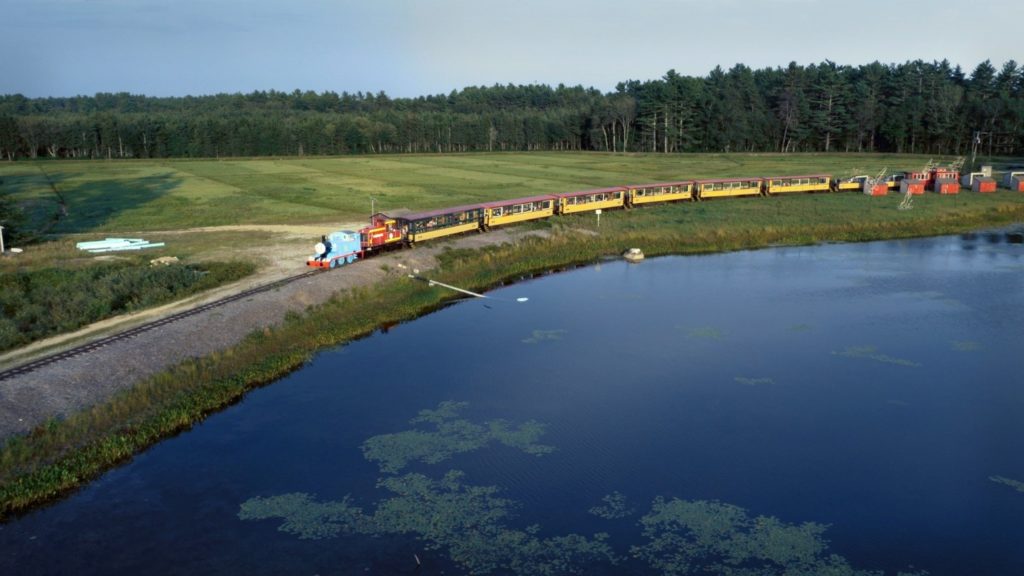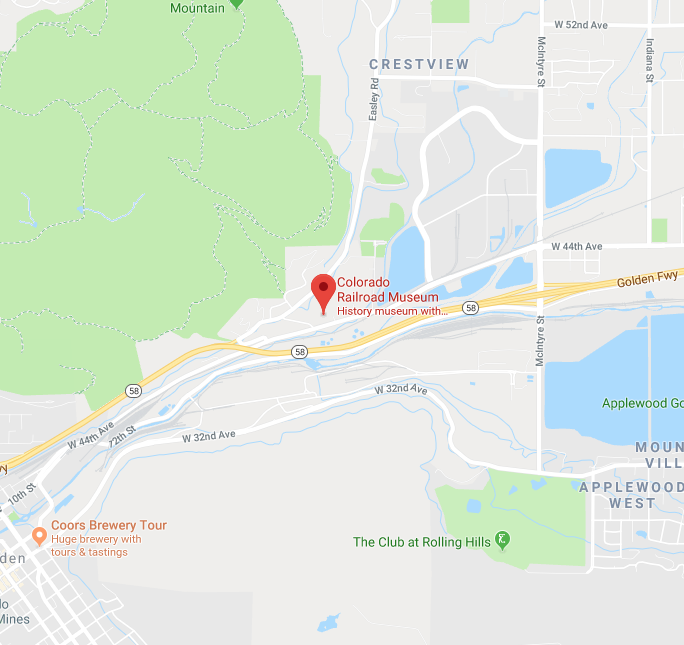Happy December!
Nearly every railroad developed a special holiday meal for passengers traveling by train over the Thanksgiving and Christmas holidays. For this month’s posting, we are looking into the history of and recipes for an American holiday staple: cranberry sauce.
Cranberry sauce is a highly debatable subject, as people argue whether the canned, jellied type of sauce is the only way one should serve it, or if the homemade “relish” style is correct. Still others make a Jell-o salad version. During the research for this posting, it became clear that the railroad versions of the sauce are just as variable as the opinions about it.
Before we get into the railroad recipes for this iconic sauce, we should look at how cranberries came to be such a prominent feature of holiday meals. The cranberry is an interesting fruit, as not only is it native to the Americas, but it is also one of only three native produce items commercially grown in the United States (the other two being blueberries and Concord grapes). Indigenous peoples have raised and eaten cranberries for centuries. Even a 1672 account of the colonies remarked “Indians and English use [cranberries] much, boyling them with Sugar for a Sauce to eat with their Meat.” Furthermore, we know that cranberry sauce has been paired with turkey since at least the 18th century. In 1796, Amelia Simmons authored American Cookery, in which she suggests serving turkey with “boiled onions and cranberry-sauce.”
The history of harvesting cranberries is also quite interesting. Most people are aware of cranberry bogs where fields of cranberries are flooded in the fall, the berries release from their vines and float, and then harvesters use special machinery to gather them. This method is used because cranberries have four small air-filled chambers inside which enable them to float in water. The bog style of harvesting only dates to the late 19th/early 20th century. Before that time, cranberries were harvested “dry” and by hand. The dry method is much more time-consuming than the flooding method.
Apparently the fresh cranberries you see in the store today are still harvested dry because it causes less damage to the berries, whereas flooding is used to harvest cranberries for juices, sauces, and jellies. The damage comes from the machines used to cull the berries from the water. Cranberry bogs seem to do well in the northern and eastern states; the main states that grow them include Massachusetts, New Jersey, Wisconsin, Michigan, Maine, and most recently, the states of the Pacific Northwest. Massachusetts is perhaps the oldest commercial cranberry growing state, having started commercial cranberry farms as early as 1816.
Believe it or not, there is a Cranberry Train that you can ride today. Located in Carver, Massachusetts, this fascinating little 2-foot gauge railroad claims to be the oldest tourist railroad in the United States. It was founded in 1947 by Ellis D. Atwood, a cranberry farmer turned rail enthusiast. Just like Bob Richardson did for the Colorado Railroad Museum, Atwood purchased narrow-gauge rolling stock from companies that downsized or closed their operations in the 1940s. Having gathered locomotives and passenger cars from Bridgton and Saco River, Monson, and others, he then laid track around his 1,800-acre cranberry bogs so he could easily transport supplies and berries to and from the bogs. He named his railroad “Edaville” after his initials E.D.A. Neighbors and friends were excited to ride his train through the bogs, so Atwood offered rides for free. His popularity only grew from there, so he eventually started charging a nickel per ride. After World War II, the popularity of the railroad as a tourist destination eventually outweighed the need to use the trains for business on the farm, so he converted his tiny railroad into a tourist railroad which would eventually become an amusement park with other attractions and rides. Although the original locomotives and rolling stock have moved on to museums, the railroad—after many changes—reopened in 2011. Have you been to Edaville to ride the Cranberry Train?
We hope you enjoy trying any of the following recipes from the Union Pacific, Fred Harvey, or Pullman. Happy Holidays, from all of us at the Colorado Railroad Museum!
***
Union Pacific Cranberry Sauce
Pick cranberries over carefully, remove all stems, wash thoroughly and place in pot, add 1 cup water to each pound of berries, and allow to boil 5 minutes and then add 1 lb of sugar for each 1 lb of berries, cover pot and simmer for 10 to 15 minutes. Do not stir with spoon, but toss berries now and then by aid of handles on pot. Pour into storage jar, cover tightly and allow to cool before putting into ice box. Berries should be clear and whole when served. For cranberry jelly puree through Chinese strainer. Coffee Saucer Nut Dish Ramekin On lettuce leaf on plate with entrée Garnish.
Dated 2/13/40
***
Fred Harvey Cranberry Mold
Ingredients:
1 cup crushed and drained pineapple (reserve juice)
2 packages of cherry Jell-O
1 cup sugar
1 ½ cup boiling water
Cottage Cheese
1 tablespoon fresh lemon juice
¾ cup chopped walnuts
1 ½ cup raw cranberries
1 cup chopped celery
1 cup ground whole orange (remove seeds)
Green maraschino cherries
Instructions:
Dissolve Jell-O and sugar in hot water; add pineapple syrup and lemon juice. Chill until the mixture is partially set. Add all other ingredients. Pour into any shape mold or individual molds. Fill center with cottage cheese, and garnish with green maraschino cherries. Serves 10-12 people.
***
Pullman Cranberry Sauce
Past Dining on the Rails Posts:
Dining on the Rails: Oyster Stuffing!
Dining on the Rails: October – Chicken Pot Pie
Dining on the Rails: September – Chili
Dining on the Rails: August – Pullman “Tom Collins” Cocktail
Dining on the Rails: June – How about a salad?
Dining on the Rails – Atchison, Topeka & Santa Fe Ham!
Dining on the Rails: CRI&P’s New England Boiled Dinner
Dining on the Rails: A Sweet Treat for your Valentine!
Dining on the Rails: Black Eyed Peas!
Dining on the Rails: Eggnog
Dining on the Rails: Happy Thanksgiving!
Dining on the Rails: Union Pacific Apple Pie
Dining on the Rails, August 2020
Dining on the Rails, July 2020
Dining on the Rails, June 14, 2020
Dining on the Rails, June 7, 2020
Dining on the Rails, May 31, 2020
Dining on the Rails, May 24, 2020
Dining on the Rails, May 17, 2020
Dining on the Rails, May 10, 2020
Dining on the Rails, May 3, 2020
Dining on the Rails, April 26, 2020
Dining on the Rails, April 19, 2020
Dining on the Rails, April 12, 2020









0 Comments